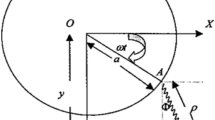Abstract
In this work, as a continuation of rigorous solutions of the mathematical pendulum theory, calculated dependences were obtained in elementary functions (with construction of plots) for a complete description of the oscillatory motion of the pendulum with determination of its parameters, such as the oscillation period, deviation angles, time of motion, angular velocity and acceleration, and strains in the pendulum rod (maximum, minimum, zero, and gravitational). The results of calculations according to the proposed dependences closely (≪1%) coincide with the exact tabulated data for individual points. The conditions of ascending at which the angular velocity, angular acceleration, and strains in the pendulum rod reach their limiting values equal to \(2\sqrt {\frac{g} {l}} ,0.77\frac{g} {l}\) and 5m 1 g, respectively, are shown. It was revealed that the angular acceleration does not depend on the pendulum oscillation amplitude; the pendulum rod strain equal to the gravitation force of the pendulum R s = m 1 g at the time instant \(t \approx 1\sqrt {\frac{1} {g}}\) is also independent on the amplitude. The dependences presented in this work can also be invoked for describing oscillations of a physical pendulum, mass on a spring, electric circuit, etc.
Similar content being viewed by others
References
N. A. Kil’chevskii, A Course of Theoretical Mechanics (Nauka, Moscow, 1972), Vol. 1 [in Russian].
V. G. Vil’ke, Theoretical Mechanics (MGU, Moscow, 1991) [in Russian].
L. G. Loitsyanskii and A. I. Lur’e, A Course of Theoretical Mechanics, Vol. 2: Dynamics (Nauka, Moscow, 1983) [in Russian].
C. Kittel, W. D. Knight, and M. A. Ruderman, Mechanics (McGraw-Hill, New York, 1965; Nauka, Moscow, 1971).
I. N. Veselovskii, Essays on the History of Theoretical Mechanics (Vysshaya Shkola, Moscow, 1974) [in Russian].
K. N. Anakhaev, Power Tech. Eng. 42, 273 (2008).
K. N. Anakhaev, in Engineering Systems 2009 (RUDN, Moscow, 2009), Vol. 2, pp. 588–595.
K. N. Anakhaev, Prirodoobustroistvo, No. 1, 72 (2014).
E. Jahnke, F. Emde, and F. Lösch, Tables of Higher Functions (McGraw-Hill, New York, 1960; Nauka, Moscow, 1977).
L. Milne-Thomson, in Handbook of Mathematical Functions, Ed. by M. Abramowitz and I. A. Stegun (National Bureau of Standards, 1972; Nauka, Moscow, 1979), pp. 587–607.
L. Milne-Thomson, in Handbook of Mathematical Functions, Ed. by M. Abramowitz and I. A. Stegun (National Bureau of Standards, 1972; Nauka, Moscow, 1979), pp. 569–586.
K. N. Anakhaev, Dokl. Phys. 50, 154 (2005).
K. N. Anakhaev, Vestn. RUDN, Ser. Mat. Inform. Fiz., No. 2, 90 (2009).
Author information
Authors and Affiliations
Corresponding author
Additional information
Original Russian Text © K.N. Anakhaev, 2014, published in Doklady Akademii Nauk, 2014, Vol. 459, No. 3, pp. 288–293.
Rights and permissions
About this article
Cite this article
Anakhaev, K.N. A contribution to calculation of the mathematical pendulum. Dokl. Phys. 59, 528–533 (2014). https://doi.org/10.1134/S1028335814110081
Received:
Published:
Issue Date:
DOI: https://doi.org/10.1134/S1028335814110081



